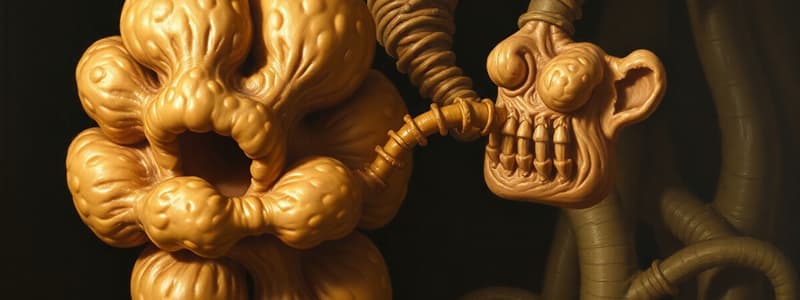Podcast
Questions and Answers
Which type of gland is characterized by the presence of ducts?
Which type of gland is characterized by the presence of ducts?
- Exocrine glands (correct)
- Holocrine glands
- Endocrine glands
- Apocrine glands
What is the primary function of a gland?
What is the primary function of a gland?
- To secrete various products such as hormones and enzymes (correct)
- To absorb nutrients from the bloodstream
- To filter waste products from the body
- To connect different types of tissues
What secretion mechanism involves cell death as part of the secretion process?
What secretion mechanism involves cell death as part of the secretion process?
- Holocrine secretion (correct)
- Apocrine secretion
- Endocrine secretion
- Merocrine secretion
Which of the following glands do not have a direct connection to the surface due to the degeneration of their ducts?
Which of the following glands do not have a direct connection to the surface due to the degeneration of their ducts?
What type of secretion involves the product being released without loss or damage to the plasma membrane?
What type of secretion involves the product being released without loss or damage to the plasma membrane?
What distinguishes endocrine glands from exocrine glands?
What distinguishes endocrine glands from exocrine glands?
Which type of gland actively releases its secretion via exocytosis?
Which type of gland actively releases its secretion via exocytosis?
Which of the following secretory mechanisms involves the complete loss of cellular integrity?
Which of the following secretory mechanisms involves the complete loss of cellular integrity?
What is a primary characteristic of glandular epithelium?
What is a primary characteristic of glandular epithelium?
Which example illustrates a merocrine secretion mechanism?
Which example illustrates a merocrine secretion mechanism?
What type of product do exocrine glands primarily secrete?
What type of product do exocrine glands primarily secrete?
Which of the following options is NOT a typical characteristic of exocrine glands?
Which of the following options is NOT a typical characteristic of exocrine glands?
What best describes the secretion from apocrine glands?
What best describes the secretion from apocrine glands?
What role do connective tissues play in the function of glands?
What role do connective tissues play in the function of glands?
Which one of the following is typically produced by a mammary gland?
Which one of the following is typically produced by a mammary gland?
Study Notes
What is a gland?
- An organized collection of secretory epithelial cells
- Created during development by epithelial cells proliferating and projecting into connective tissue
- Can be categorized as exocrine or endocrine glands
Exocrine Glands
- Secrete products into ducts that open into an organ's lumen or onto skin
Endocrine Glands
- Ductless glands
- Secrete directly into tissue spaces which eventually enter the bloodstream
Secretory Mechanisms
-
Merocrine
- Products pass from cells without damaging the plasma membrane
- Secretion via exocytosis
- Most common secretion method
-
Holocrine
- Cell debris is part of the secretion
- Involves death of the cell
- Example: Sebaceous glands
-
Apocrine
- Note: The document is missing the full example for this secretory mechanism
- Missing information: The document lacks details concerning how the Apocrine glands secrete as a specific example.
Glands
- An organized collection of secretory epithelial cells
- Form during development via epithelial cell proliferation
- Project into underlying connective tissue
- Classified as exocrine or endocrine
- Exocrine glands retain continuity with surface via a duct
- Endocrine glands lose connectivity with surface as their ducts degenerate during development
Glandular Epithelium
- Secrete a wide range of products including:
- Hormones
- Enzymes
- Milk
- Sweat
- Mucous
- Oil
Gland Classification
- Exocrine
- Pour products into ducts that open into a lumen of an organ or onto the skin
- Endocrine
- Have no duct system, they are ductless
- Secrete into empty tissue spaces, eventually entering the bloodstream
Secretory Mechanisms
- Merocrine
- Exocytosis
- Secretion passes from cells without damage to the plasma membrane
- Most glands secrete this way
- Example: salivary gland
- Holocrine
- Secretion involves the death of the cell
- Cellular debris becomes part of secretion
- Example: sebaceous gland (secretes sebum)
- Apocrine
- Mechanism not well understood
- May be a variation of merocrine
- May involve pinching off of the apical portion of the cell
- Example: mammary glands (lactation)
Studying That Suits You
Use AI to generate personalized quizzes and flashcards to suit your learning preferences.
Related Documents
Description
This quiz covers the fundamental concepts of glands, including their classifications into exocrine and endocrine types. It explores the various secretory mechanisms such as merocrine, holocrine, and apocrine. Test your knowledge on how these systems work and their biological significance.




